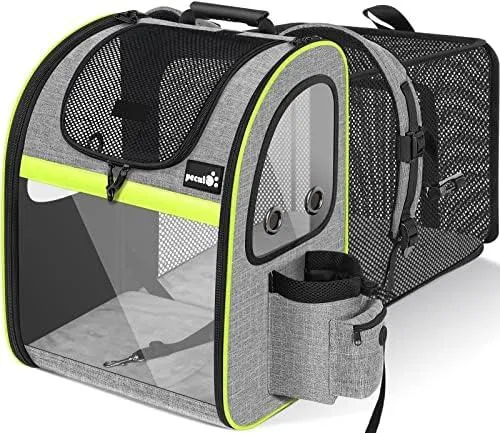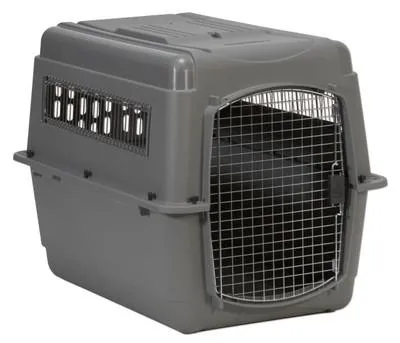Your Guide to Traveling with Pets by Air
Whether you’re planning a vacation or relocating to a new home, traveling with your furry companions by plane can be stressful. As an experienced pet owner who has faced my fair share of headaches at the airport, I’ve put together this guide to answer all your questions about using airline kennels and transporting pets safely. By following these tips, you can relax knowing Fluffy or Fido will have a smooth flight.
Choosing the Right Kennel
Airlines require pets to be contained in hard-sided kennels that meet certain size limits during takeoff, landing, and transport between planes. The kennel is basically your pet’s personal carrier throughout the process. When shopping, look for a kennel labeled “airline approved” that is spacious enough for standing, turning around, and stretching out comfortably.
Soft-sided carriers don’t provide enough protection from potential falls or other damage, so avoid those. Plastic or metal kennels are best. Make sure latches and hinges are secure to prevent accidental opening. It may seem sort of like overkill, but a back-up leash attached to the kennel can give extra peace of mind in case of any mishaps. You definitely don’t want Fido making a break for it at the baggage carousel!
Booking Your Pet’s Ticket
Most airlines only allow one pet per person traveling, so if you’ve got multiple fur babies, you may need extra humans along for the ride. Carriers must be checked as cargo on all flights, not in the passenger cabin, so be prepared for an additional pet ticket fee that varies by airline and animal size. These days, prices for pets in the cargo hold seem to be kind of outrageous at around $200 each way for domestic flights in the U.S. But I guess the airlines gotta pay the vet bills somehow, right?
When booking, notify the airline agent that you will be traveling with a pet. Ask about size/weight limits and required health documents. Provide your pet’s details like species, height/length, weight, veterinary records, and proof of vaccination/ identification microchip. Make reservations well in advance since some airlines limit the number of pets allowed per flight for safety and logistical reasons.

- Check the airline’s policies on restricted breeds too. Certain dogs may be prohibited from riding as cargo.
- Inquire about animal handling procedures from ticketing to arrival. Knowing what to expect can ease stresses.
Pet Prep Before Flying
To ensure a smooth journey, pets must be properly conditioned, restrained, and identified. From my own overseas relocation ordeal years ago, I can say neglecting these steps is just asking for troubles:
- Crate train your pet well in advance using positive reinforcement. Get them accustomed to being in their kennel for long periods.
- Schedule a vet check-up no less than 10-14 days prior. Pets need updated vaccinations and health certificates to cross borders.
- Sedatives may help anxious pets, but get your vet’s guidance on appropriate medications and dosage timing.
- Attach ID tags on collars and engrave info on kennels in case of any separation during travel.
- Withhold food for at least 4-6 hours before a flight to avoid risks of dehydration or vomiting. Provide water until check-in.
What to Bring Along
In addition to the essential ID tags and documents, these extras can aid your pet’s airport experience:
- Multiple frozen water bottles or gel packs to line the kennel floor and walls – cabin temperatures fluctuate drastically.
- Absorbent pads or newspapers – accidents may occur despite best efforts
- A few chew treats and toys for enrichment – distract anxious flyers with familiar scents and textures
- A leakproof travel bowl for food/water – help contains spills during transport
- Moist wipes and baggies for cleanups – no one wants a smelly kennel!
- Your phone number written clearly on the kennel – a direct line for handlers if needed
Basically, be over-prepared like any good boy scout. A well-organized pet owner faces way fewer hassles than those who show up empty-handed on D-day.
Airline Check-In Process
When dropping off Fido at the cargo hold, allow extra time for check-in. Airlines have detailed procedures to ensure safe animal transport:
- Visit the cargo counter well before your scheduled departure. Delays are less stressful for all parties when there’s a time buffer.
- Present veterinary documents, valid ID, pet ticket, and health/rabies certificates for review. Official checks avoid rejections down the line.
- Have your kennel pre-labeled per airline rules and securely sealed/latched. Double check it meets all carry-on specifications before handing over.
- Staff may weigh and measure kennels once more for verification. Don’t feel rushed but remain polite if lines are long.
- Get receipts listing your flight info and expected arrival dates or have them emailed. These are proof of delivery should issues arise.
A representative will escort kennels to be stowed according to dangerous goods protocols. Wishing your pet “bon voyage” is toughest part! But obey signs and stay until cargo doors close before leaving airport grounds.

Arriving at Your Destination
While air travel poses limited risks according to industry reports, problems can crop up due to unforeseen delays or mishandling. To prepare for arrival hassles:
- Check flight statuses frequently and have contacts at both origin and destination airports just in case. Lost pet scenarios need rapid responses.
- Allow a grace period post-scheduled arrival before getting antsy. Baggage systems aren’t error-proof and staff safety checks lengthen disembarking.
- Ensure someone is present to claim your pet promptly. Don’t subject critters to lengthy waits at baggage claim!
- Confirm animal handling protocols if flights are missed or kennels become misrouted. Escalate issues respectfully to supervisors as needed.
From bitter experience scrambling for my lost pup during delayed mid- Atlantic layovers, I can say it pays to be patient yet proactive. With the right precautions, your four-legged family members should arrive safe and sound at journey’s end.
Alternatives to Air Transport
If the stress of air travel makes you or your pet too uneasy, other modes exist. However, each has drawbacks:
- Driving allows control but multi-day trips tire pets and humans. Consider rest/motel stops every 4-6 hours.
- Commercial ground transport businesses like PetRelocation span great distances in comfortable vehicles with vet tech attendants for minor injuries/sickness en route. But they cost roughly 2-5 times as much as airline cargo.
- Shipping via bus or train exposes pets to major terminal hubs with attendant disease risks compared to direct flights. Monitor schedules and expect longer transit times vs planes.
- Hiring private pet pilots for short-hop flights in small aircraft can work for very high-maintenance fliers. But costs are astronomical, on par with African safaris!
In summary, air travel – while not quite “business class” for pets – presents the safest option for most pooches and their people when relocating long-distances. Proper planning and precaution go a long way in keeping everyone’s travel experience paw-some. Safe skies to all Fido Fanciers!
Key Considerations When Choosing an Airline Travel Kennel
| Feature | Details |
|---|---|
| Size | Choose a kennel that allows your pet to stand up and turn around comfortably but is not too large to squeeze under the seat. |
| Ventilation | Look for a kennel with mesh sides or top for adequate airflow during the flight. |
| Durability | Choose heavy-duty plastic or metal over thinner materials to protect against damage from baggage handling. |
| Escape-Proof Lock | The locking mechanism should securely close to prevent your pet from escaping during travel. |
| Handles | Handles on the top and sides make the kennel easy to lift and carry through the airport. |
| Complies with Airline Requirements | Ensure the kennel meets size limits and other rules for the airline you are flying. |
FAQ
-
Can I bring my dog on the plane in a carrier?
Most airlines will allow you to bring your small dog or cat on board in an approved kennel. However, some have restrictions on size and breeds. You’ll need to check the rules for your specific airline.

-
What size kennel is allowed?
Kennels must usually fit completely under the seat in front of you. Measurements are around 18 inches by 14 inches by 9 inches or smaller. Anything bigger might not fit safely or be let on board. Always confirm the exact sizing rules when booking your flight.
-
Do I need paperwork for my pet?
To travel with a pet on a plane, you’ll basically need vaccination records, an up to date health certificate, and to follow IATA guidelines. Each airline can have their own rules too, so review everything carefully before your trip. Proper docs are a must or else they won’t let Fido fly!
-
How much does it cost to bring a dog on a plane?
Airline travel pet fees can vary a lot. Some charge around $125 each way while others go way higher, like $200+. There might also be additional charges depending on the animal’s size. You’ll have to look at each individual airline to see what they charge. It’s not necessarily cheap to bring your furry friend along!
-
Is it stressful for dogs to fly?
The cabin pressure changes and engine noise could potentially be disorienting or stressful for animals. However, on the other hand, many experts say that with proper training and by keeping them in a familiar kennel, pets can tolerate flight okay. But perhaps it depends on the individual dog. Their comfort is important to consider.
-
What’s the safest way to transport a dog on a plane?
For best results, only use an FAA-approved hard-sided kennel that’s properly sized and labeled. Also consider sedation prescribed by your vet. Some folks claim a thundershirt or other calming aid can help. No matter what, be sure to check guidelines closely with your specific airline. Taking every precaution is best for dog and human piece of mind!

In summary, while airline travel with pets in kennels is allowed, there are clear rules around sizing, documents, costs and safety to follow. As long as you plan ahead and get the details right from the start, bringing your furry companion along could maybe work out okay. But high fees, stress on the animal, and potential issues mean it’s not necessarily the best option either. You’ve got to decide what works for Fido and your unique situation.
